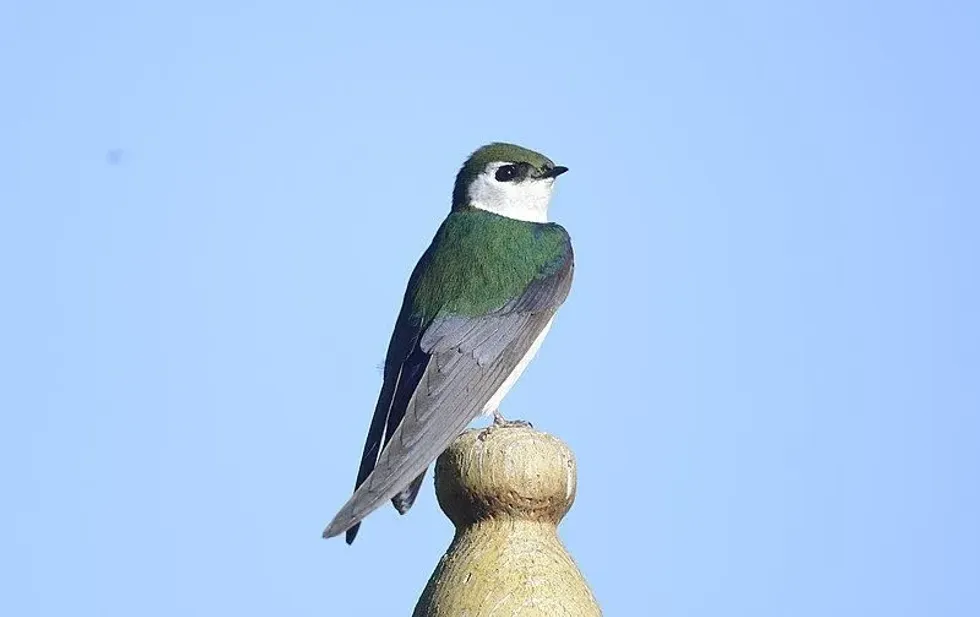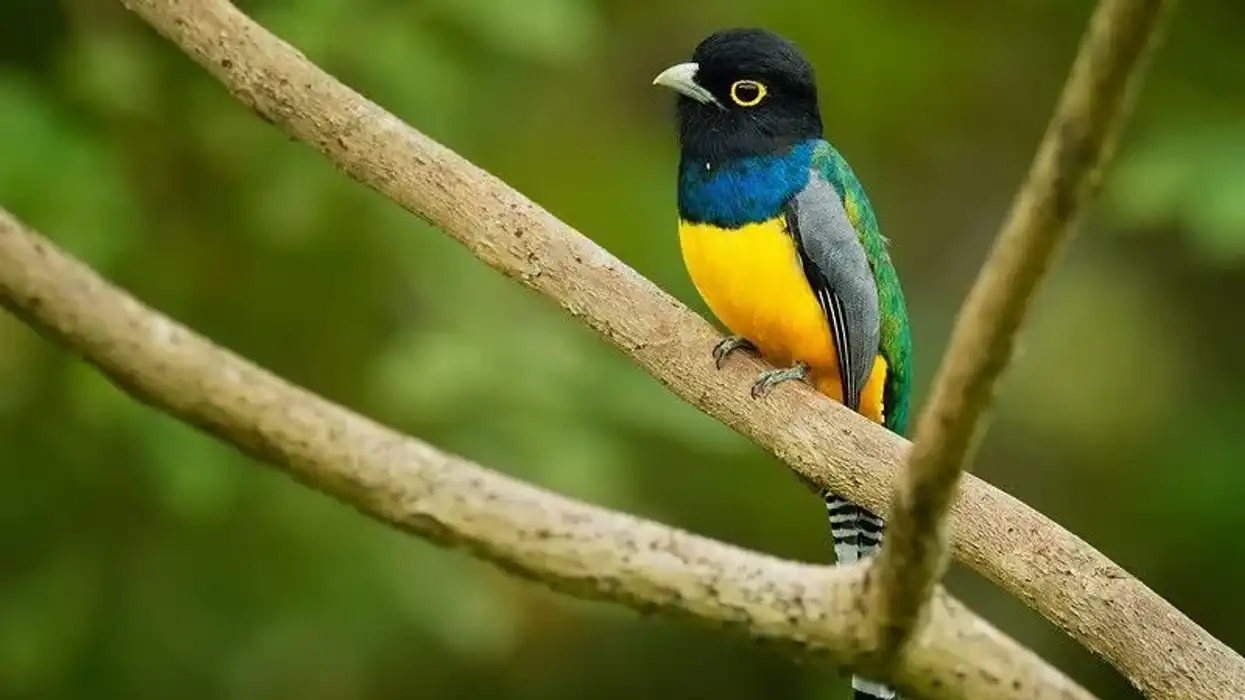Dwelling in the depth of wild coniferous and deciduous forests of Northern America, the Violet Green swallow (Tachycineta thalassina) is a one-of-a-kind organism. Away from the loud, polluted areas of the city reside these beautiful, small songbirds.
'Che-che-che', if you hear this, then you are in the right place to look for them. Violet Green swallows are gorgeous and colorful birds attracting a lot of bird sighters.
The distinctive body shape of Violet Green swallows differentiates them from other birds of the same species.
These birds of North America have long pointed wings and streamlined body has evolved to prey on insects while flying. An adult Violet Green swallow closely resembles the North American tree swallows in terms of appearance.
Here are some of the most important facts about Violet Green swallows for your perusal. Afterward, do check our other articles on the cliff swallow and lilac-breasted roller as well.
Violet Green Swallow Interesting Facts
What type of animal is a Violet Green swallow?
The Green Violet Swallow is a small, cute little bird with small wings and a small beak that belongs to the swallow family of birds. This one-of-a-kind creature dwells in the wild and attracts a lot of bird sighters.
If you visit a forest in Northern America and use a range map and bird guide, then you may spot Violet Green swallows hiding in the tree.
What class of animal does a Violet Green swallow belong to?
The Violet Green swallow is a bird and it belongs to class Aves of kingdom Animalia. It is a member of the family named Hirunidae, which is a family of passerine birds.
How many Violet Green swallows are there in the world?
For now, there are about 19 known species of a Violet Green swallow bird belonging to the genus Tachycineta. It is estimated and calculated that there are about 7 million breeding Violet Green swallow birds present globally at the moment.
Where does a Violet Green swallow live?
This insectivore is native to North America. Their population is distributed widely in various regions such as West Coast Alaska, Mexico, East Montana, Washington, and Texas.
In these regions, violet green swallows are spotted in a variety of forests such as deciduous and coniferous forests and just not that, and they are also found nesting in cliff areas. Seven members of the swallow family breed in Washington.
What is a Violet Green swallow's habitat?
A Violet Green swallow is called a secondary cavity nester. This means that they do not create their nesting site. Rather, Violet Green swallows nest in the already present cavities in the wild.
This species builds its nests in tree holes, nest boxes, or cracks in large cliffs. At the bottom of these cavities, both males and females create cup-like nests with the aid of grass, stem, and twigs. The construction of the nests takes up to 20 days maximum at the nest site.
Who do Violet Green swallows live with?
One may find these birds nesting in solidarity. But as per the Cornell Lab of Ornithology, it is more common to spot these passerine birds nesting in colonies, where about 25 pairs of these birds dwell together.
How long does a Violet Green swallow live?
A Violet Green swallow lives for a decent number of years. Their average life span is about six years and eight months. The longest-living Violet Green swallow was a male bird that lived for nine years in total.
How do they reproduce?
Birds, in general, are oviparous and lay eggs in their nests where their young ones are nurtured with care. This bird migrates to its nests for copulation and breeding.
The female Violet Green swallow lays eggs in June, with a clutch size of five eggs on average. Interestingly, the female does not lay all eggs at once but lays one egg per day.
What is their conservation status?
These birds fall in the category of Least Concern species in terms of conservation status. From 1966-2015, a decline of 28% in their population has been reported by the North American Survey of Breeding Birds. This unfortunate decline in their number is due to a variety of reasons, use of insecticide, pollution, and rapidly changing climate to name some.
Violet Green Swallow Fun Facts
What do Violet Green swallows look like?
A Violet Green swallow is a small songbird found residing in open woodland near water bodies. It has long, slim wings for faster flight and a tail that is forked.
Adult male birds have a presence of white coloration under the beak and the head is a color of shiny green. The body of a Violet Green is colored with a white rump and there is a hint of violet on the back of its body and a forked tail.
How cute are they?
These are very cute birds because of their Violet Green color, white rump, and forked tail. Especially because of their size and the unique Violet Green and white coloration of their body, this tree swallow species attracts a lot of bird sighters during its flight as well as during the migration.
How do they communicate?
These songbirds have a unique call. These social birds use 'chee-chee' sounds while interacting with other birds of their species.
These interactions include fighting for nests with other swallow birds, a young one calling an adult wanting to be fed, and moving around in flocks. This bird species also have a distinct call which this species uses for courtship display and escorting female birds for breeding activities.
How big is a Violet Green swallow?
It is a small bird with an average body length of 5.2-5.5 in (13.2-13.9 cm) and a wingspan of up to 10.6 in (26.9 cm). This bird is three times smaller than urban crows. Their small body length enables them to have good flying abilities.
How fast can a Violet Green swallow fly?
A Violet Green swallow is a really fast bird. The swallow can fly at an average speed of 40 mph (64.3 kph). Since these birds of British Columbia dwell in the wild and are at risk of being easy prey, they fly faster and at a decent height.
How much does a Violet Green swallow weigh?
A Violet Green swallow may weigh around 0.45-0.49 oz (0.011-0.012 kg) on average. These birds of British Columbia are lightweight because their bodies do not store a lot of fat. Their lightweight helps them fly higher and better.
What are the male and female names of the species?
The males and females of this species of British Columbia are known as male and female violet green swallows respectively. Males have white cheek patches whereas the females and babies have dusky-colored cheek patches.
What would you call a baby Violet Green swallow?
A baby Violet Green swallow is called a fledgling. A fledgling stays in the nest after hatching with the mother swallow bird after birth for a few days. After they acquire feathers for flight, the young birds leave the nests with their parents for foraging activities near their habitat.
What do they eat?
Violet Green swallows are insectivores that feed on a variety of flying insects. These birds get their name because they catch and eat flying insects during their flight. They feed on a wide variety of flying insects as well as ground insects such as ants, beetles, and arthropods like spiders.
Are they dangerous?
Behaviorally a Violet Green swallow is not dangerous. It may attack a fellow swallow during mating and courtship activities, but otherwise, they are not a threat to humans.
But studies show that their droppings and nests are home to a variety of bacterial and fungal species as well as some deadly parasites. These are capable of causing deadly diseases in humans such as meningitis, toxoplasmosis, and encephalitis to name some.
Would they make a good pet?
These do not make good pets as they like to feed on flying insects. They fly in open areas in the wild and reside in pairs. They may also carry disease-causing parasites that can be lethal to humans.
Did you know...
Interestingly, these nesting birds show phenomena named interspecific cooperation. This means that they form cooperative relationships with other birds.
For example, these birds with a white rump form interspecific cooperation with the bluebird in which they occupy the nests of the bluebirds and raise their fledglings in them. This species of western North America feeds their young chicks as well as the bluebirds’ fledglings in return for the safety provided by the bluebirds' nests.
Where does Violet Green swallow nest?
Violet Green swallows build their nests in naturally occurring cavities on the trees. This bird of western North America uses grasses, stems, and other natural debris to build their nests which are in the shape of a cup situated in the bottom of the cavity.
Apart from nests box and tree holes they also make their nests in the cracks of the cliffs where they can easily feed on flying insects.
What color is a tree swallow?
These birds have a variety of colors on their body. The upper part is of shiny glossy blue and green, the beak is black, and the underside of their body is white and the wings are a color of black. These birds are colorful and can also be territorially aggressive.
Here at Kidadl, we have carefully created lots of interesting family-friendly animal facts for everyone to discover! Learn more about some other birds from our marabou stork facts and Eurasian collared dove fun facts pages.
You can even occupy yourself at home by coloring in one of our swallow birds coloring pages.










